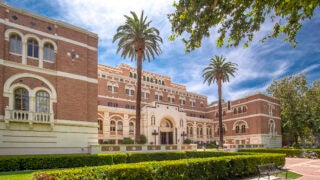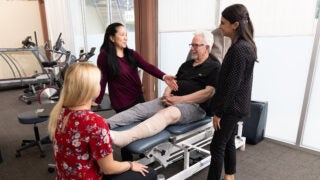USC Dornsife/LA Times Poll: Calif. voters overwhelmingly say voting is important — despite consistently low turnout
Poll results may suggest voters hold little faith in government effectiveness at all levels
Contact: Merrill Balassone at balasson@usc.edu or (213) 740-6156; Michelle Boston at msboston@dornsife.usc.edu or (213) 821-9311
A press call discussing these results is MONDAY, Sept. 14 at 11 a.m. PT. Call-in spots are limited. Call-in number: United States: (800) 230-1059 International: (612) 234-9959
Sept. 12, 2015 — According to results of the latest USC Dornsife/Los Angeles Times Poll, conducted with the California Community Foundation, more than 80 percent of California voters believe voting in an election is very important; however, voter turnout numbers contradict that figure. Only 42 percent of California registered voters cast a ballot in the 2012 general election, according to the Secretary of State’s website.
Among California registered voters responding, 81 percent felt voting was “very beneficial” to their community, 12 percent indicated it was “somewhat beneficial,” and 5 percent felt it was of little or no benefit. The poll showed nearly identical results when it came to voters’ personal benefit, with 80 percent reporting that voting was “very beneficial” to their community, 13 percent indicated it was “somewhat beneficial,” and 6 percent finding little or no return on casting a ballot.
“So the responses indicate that California voters think voting is important but many don’t actually do it,” said Dan Schnur, director of the USC Dornsife/Los Angeles Times Poll and director of the Unruh Institute of Politics of USC.
(Click here for video of Schnur and Los Angeles Times political columnist Cathleen Decker discussing these issues).
The apparent high value placed on voting by respondents to the USC Dornsife/CCF/Los Angeles Times Poll may be exaggerated, due chiefly to “social desirability,” or the desire of respondents to “give the right answer.” It does, however, give a broad indication that those same voters believe ideally that voting should provide a strong benefit to communities, according to Schnur.
That sentiment may be reflected in poll results about improving the community. When asked who is responsible for community improvement, 71 percent of voters indicated that local government bears “a lot of responsibility,” 17 percent felt it had “some responsibility,” and just 10 percent felt it had little or no responsibility.
Poll responses also show that voters are lukewarm on local government’s actual responsiveness to its constituents. Half of those polled felt local elected officials are “somewhat responsive” to members of the community, while only 16 percent felt local government is “very responsive.” Twenty-six percent listed local officials as not very or not at all responsive.
These contrasting results point to a conflict between voters’ high expectations for elected officials and their perception of mediocre action, according to David Kanevsky, research director of Republican polling firm American Viewpoint, part of the bipartisan team with Democratic polling firm Greenberg Quinlan Rosner Research that conducted the USC Dornsife/CCF/Los Angeles Times Poll.
“People want government, especially local government, to solve problems,” he said, “but they just don’t believe that it’s good at doing so.”
Personal responsibility highly valued regardless of party
While voters felt local government should bear a great deal of responsibility for leading progress, they also said that people living in the community should play an equal role. Sixty-nine percent of respondents indicated that community citizens had “a lot of responsibility,” 22 percent felt they had “some responsibility,” and only 8 percent felt they had little or no responsibility — results that closely match those indicating local government’s level of obligation.
The results indicate that voters clearly believe elected officials should do their jobs, said Drew Lieberman, vice president of Greenberg Quinlan Rosner Research, “but they’re also saying that this is still America and if you want the place where you live to be better, then you’ve got to take some responsibility for making that happen.”
Actions benefiting local communities and individuals
When queried on how certain civic actions are beneficial to their communities, voters pointed to voting (93 percent); discussing current events and public issues with family, friends or neighbors (83 percent); volunteering with civic organizations, schools or neighborhood groups (90 percent); and donating to charity (84 percent) as being very or somewhat beneficial. Fewer voters saw community benefit in attending local meetings (81 percent); participating in or joining advocacy groups (75 percent); contacting elected officials in person or via “snail-mail” (74 percent) or electronically (72 percent); volunteering for a political candidate (69 percent); and giving money to a candidate (46 percent).
When asked how these civic actions are beneficial to them personally, voters said voting (93percent); volunteering with civic organizations, schools or neighborhood groups (81 percent); donating to charity (80 percent); and discussing current events and public issues with family, friends or neighbors (82 percent) are very or somewhat beneficial. Fewer voters said attending local meetings (73 percent); contacting elected officials in person or via “snail-mail” (68 percent) or electronically (66 percent); participating in or joining advocacy groups (63 percent); volunteering for a political candidate (52 percent); and giving money to a candidate (39 percent) would be personal beneficial.
Poll participants were given a list of benefits that people might receive when they are living in a community with engaged and involved citizens. They were then asked to choose the two they felt best described those benefits. Voters chose having more residents united toward the same goals for improving neighborhoods (46 percent), improving quality of life (42 percent) and increased power to influence laws and policies (38 percent) as the top three. Providing opportunities for success (17 percent) and free services or goods (8 percent) rounded out the list.
Who should lead the charge?
When queried which groups should bear responsibility for improving their communities, poll respondents said people living in the community (91 percent) and mayors and local officials (88 percent) should bear a lot or some responsibility. Fewer voters pointed to local businesses (84 percent), nonprofit, community-based organizations (78 percent) and faith-based groups (74 percent) as sharing the same level of responsibility.
Voters were asked how responsive they felt local elected officials were to their community members. Half said officials were “somewhat responsive,” 18 percent said they were “not very responsive,” 16 percent said they were “very responsive” and 9 percent said they were “not at all responsive.”
The latest USC Dornsife/Los Angeles Times Poll, the largest statewide survey of registered voters, was conducted Aug. 29 — Sept. 8 and includes a significant oversample of Latino voters as well as one of the most robust cell phone samples in the state. The full sample of 1,500 registered voters has a margin of error of +/- 2.8 percentage points.
Additional poll results and methodology are available here.
WEBSITE: https://dornsife.usc.edu/poll
TWITTER: @usclatpoll
About the USC Dornsife College of Letters, Arts and Sciences/Los Angeles Times Poll: The USC Dornsife/Los Angeles Times Poll is a series of statewide public opinion polls in California, designed to survey voter attitudes on a wide range of political, policy, social and cultural issues.
Conducted at regular intervals throughout the year, the USC Dornsife/Los Angeles Times Poll is one of the largest polls of registered voters in the state and has been widely cited, helping to inform the public and to encourage discourse on key political and policy issues.
About USC Dornsife College of Letters, Arts and Sciences: USC Dornsife College of Letters, Arts and Sciences is the heart of the university. The largest, oldest and most diverse of USC’s 19 schools, USC Dornsife is composed of more than 30 academic departments and dozens of research centers and institutes. USC Dornsife is home to approximately 10,000 undergraduate and graduate students and more than 750 faculty members with expertise across the humanities, social sciences and sciences.
About the Los Angeles Times: The Los Angeles Times is the largest metropolitan daily newspaper in the country, with a daily readership of 2 million and 3 million on Sunday, and a combined print and interactive local weekly audience of 4.5 million. The fast-growing latimes.com draws over 10 million unique visitors monthly.
About the California Community Foundation: The California Community Foundation (CCF) leads positive systemic change to strengthen Los Angeles County. The foundation has served as a public, charitable organization since 1915, empowering donors to pursue their own personal passions and to collaborate in transforming Los Angeles. CCF stewards $1.5 billion in assets and manages nearly 1,600 charitable foundations, funds and legacies. For more information, please visit calfund.org



